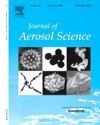Modeling aerosol bolus inhalations in the human lung with the multiple path particle deposition model: Comparison with experimental data
IF 3.9
3区 环境科学与生态学
Q2 ENGINEERING, CHEMICAL
引用次数: 0
Abstract
Existing one-dimensional (1D) models of aerosol dosimetry often ignore mixing mechanisms of inhaled aerosols during their transport in the lung. This mixing or aerosol dispersion results from different physical mechanisms in different regions of the lung. It is a higher order effect, which cannot be directly captured in 1D modeling approaches, and thus is sometimes modeled as a diffusive process. In this study, we improved our recently developed alveolar mixing module incorporated in the multiple path particle dosimetry model (MPPD) to account for flow irreversibility and particle trapping in the alveolar spaces, as well as mixing occurring in the tracheobronchial region. This new version of MPPD was coupled with CFPD-based predictions of aerosol bolus dispersion in the oral airway. The model was used to predict the deposition, dispersion, and mode shift of aerosol bolus inhaled at different penetration depths within the lung for breathing patterns and particle size matching those used in a previous experimental study (Darquenne et al., 2016). Even though a quite simplified approach was used, the computations appear to describe subject-specific and test-specific experimental data reasonably well. The proposed combined dispersion-deposition model can be a useful tool for targeted drug delivery and also for exposure health risk assessment.
用多路径粒子沉积模型模拟人体肺部气溶胶丸吸入:与实验数据的比较
现有的一维(1D)气溶胶剂量学模型往往忽略了吸入气溶胶在肺部运输过程中的混合机制。这种混合或气溶胶分散是由肺不同区域的不同物理机制造成的。这是一种高阶效应,在一维建模方法中不能直接捕获,因此有时被建模为扩散过程。在这项研究中,我们改进了我们最近开发的肺泡混合模块,将其纳入多路径颗粒剂量学模型(MPPD)中,以考虑肺泡空间中的流动不可逆性和颗粒捕获,以及发生在气管支气管区域的混合。这种新版本的MPPD与基于cfpd的气溶胶丸在口腔气道中的分散预测相结合。该模型用于预测吸入不同穿透深度的气溶胶丸在肺内的沉积、分散和模式转换,以获得与先前实验研究中使用的呼吸模式和粒径相匹配的结果(Darquenne et al., 2016)。尽管使用了一种相当简化的方法,但计算似乎很好地描述了特定科目和特定测试的实验数据。所提出的分散-沉积联合模型可作为靶向给药和暴露健康风险评估的有用工具。
本文章由计算机程序翻译,如有差异,请以英文原文为准。
求助全文
约1分钟内获得全文
求助全文
来源期刊

Journal of Aerosol Science
环境科学-工程:化工
CiteScore
8.80
自引率
8.90%
发文量
127
审稿时长
35 days
期刊介绍:
Founded in 1970, the Journal of Aerosol Science considers itself the prime vehicle for the publication of original work as well as reviews related to fundamental and applied aerosol research, as well as aerosol instrumentation. Its content is directed at scientists working in engineering disciplines, as well as physics, chemistry, and environmental sciences.
The editors welcome submissions of papers describing recent experimental, numerical, and theoretical research related to the following topics:
1. Fundamental Aerosol Science.
2. Applied Aerosol Science.
3. Instrumentation & Measurement Methods.
 求助内容:
求助内容: 应助结果提醒方式:
应助结果提醒方式:


